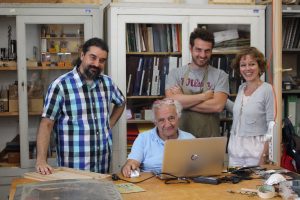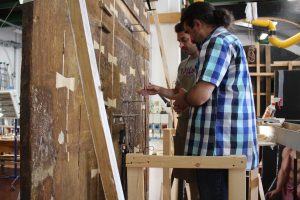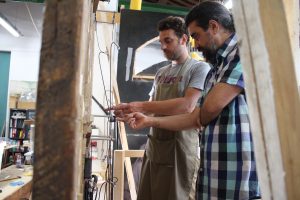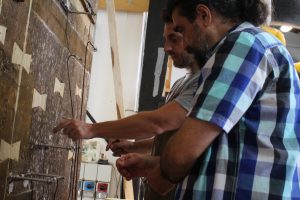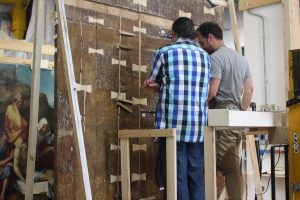A researcher at the Opificio delle Pietre Dure: Andreas Sampatakos
This science story mixes together two elements: a laboratory of carpentry and a specific genre of paintings: the icons.
The Laboratory of carpentry is a section of the Opificio delle Pietre Dure, one of the most important and pioneer center for restoration in the world and training school for new generation of restorers. Located in Florence, it participates in IPERION CH. The long experience and the continuous updating to new technologies makes the laboratory one of the most prestigious place where wooden artifacts are treated and restored.
The other ingredient of the story is icons, that are devotional paintings of Christ or another holy figures, typically executed on wood and used ceremonially in the Byzantine and Orthodox Churches. This represents one of the enduring forms of religious art ever developed.
These elements are really different from each other, but if a researcher comes from Greece to Italy the story can change.
In August 2018, Andreas Sampatakos was in Florence and he was looking for wooden secrets in the laboratory and archives in OPD. He is a tutor of conservation of icons and wooden artifacts in the department of Conservation of Antiquities and Works of Art at the University of West Attica. He has worked for more than 20 years as an art conservator/expert, specialized on panel paintings and wooden artifacts, in the Municipal Gallery of Athens and the Byzantine and Christian Museum of Athens.
He asked access to the OPD archives and laboratories with the aim of catching information by the Italian experience in conserving and treating wooden panels and works of art. He wants to increase his technical and theoretical knowledge in the field, learn a systematic methodological approach and transfer it to Greece as part of the structural conservation of wooden paintings and artifacts.
If you are reading this post and you are curious, read the short interview with Andreas Sampatakos below.
What did you expect from ARCHLAB?
My aim of this project was to study: a) the structural conservation methods of panel paintings that have been developed in OPD and their application, and b) elements of construction techniques of Italian panel paintings. By having access to the documents/case studies and the specialists of OPD, I could have more inside information additional to what is published by OPD. The expectation was to study both the theory and practice that OPD is undertaking on addressing structural problems on panels and also the improvements that have been occurred.
Could you tell us something about what you have learned from this experience?
I was very lucky to encounter with quite many interesting topics that have enhanced my knowledge and understanding of the panel’s behavior and conservation.
I was able to get information and to understand more of the procedure that panels are examined in OPD. Panel construction, typology of wood damages and specifically the condition of the paint layers indicate the wood tendency and stress and strain that each panel has undergone. This empirical examination is an essential stage in estimating the amount of curvature that is necessary to be given to panel during the conservation process as well as on designing the adequate type of supporting system.
I was able to get information about different supporting systems that have been applied to panels by OPD and the related engineering. The more contemporary spring system designed by OPD was studied in full detail and I was given the opportunity to understand better the relation of parameters such us the elasticity of the crossbar/ frame, the type and number of sprigs and their tension.
The philosophy and technical parameters on designing and constructing flexible/curved crossbars and supporting frames were also studied in detail. I was able to learn many technical/practical aspects of that topic as well as the different factors and material properties that are affecting their elasticity or stiffness. Particular treatments were examined such us modifying original cross bars into more elastic as well as the related mechanical tests and measurements.
I had the privilege to study also various types of treatments on wooden supports such us the V shaped inserts or the tassellatura with emphasis on their application methods, practice, tools and materials. Coming close to this know how of OPD was extremely valuable to me.
In a parallel way, I was able to study also aspects of historic processes of shaping wood on the back of the panels, with emphasis on the tool marks and traces of these construction techniques.
Did you find any relevant results/conclusions?
Yes, the information that I have gained during this scholarship was very meaningful and they will become quite useful also in my thesis research on conservation issues of panel paintings of Greece.
As I have already mentioned I was able to understand more of the survey of panel’s behavior and the designing of supporting systems. A major part of this process is based on an empirical understanding and survey and this experience is hard to be transmitted. At the same time, I was able to see the projects that OPD is undertaking in partnership with other institutions in order to measure and parameterize these factors.
It became clearer to me, why older supporting systems perform some disadvantages while simpler contemporary mechanical systems have a better operation.
OPD has a long history on panel paintings’ conservation and it is one of the very few institutions that masters a compact know-how and ability to execute major conservation treatments. This was evident and it made a difference to me as I was focusing on the methodology and the practical application of structural treatments.
During this project, I was able to compare the conservation philosophy and approaches followed in Greece and the approaches of OPD. In some cases, the two parts follow somehow a common philosophy but there are quite many cases that the conservation approach is totally different. This comparison is a topic of quite an interest that initiates questions that can be comprehended in my thesis research. Large wooden panels are rare in Greece and in OPD it was possible to see how these are treated.
An additional benefit from this project was the opportunity of networking with conservators of OPD. This is very significant as a dialog has started and it is promising that it can continue.
I am grateful to IPERION CH project for approving and founding this scholarship in OPD. Dr. Monica Galeotti from the first day of this project was extremely supportive. She was also very helpful in the archives. Christiana Massari undertook all the bureaucratic and practical issues of the project in a very smooth and positive way. Andrea Santacesaria and Ciro Castelli with no hesitation provided the documents, explained and shared their wide knowledge with me. Alberto Dimuccio in a very professional manner provided information and for many hours he was translating for me. His help was valuable. This project could not have been realized without the encouragement and support of a very good friend Dr. Sofia Sotiropoulou from Greece. I thank her so much. Finally, I would like to make a comment on the friendly reception that I have received from the personnel of OPD. I thank all these people for their aid in this learning experience.

